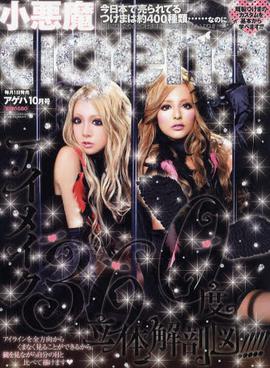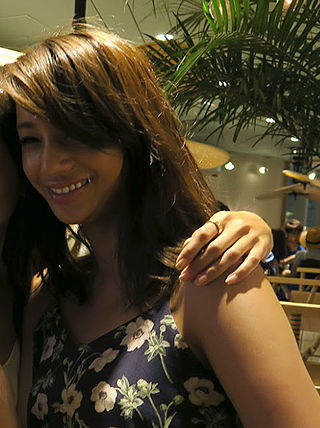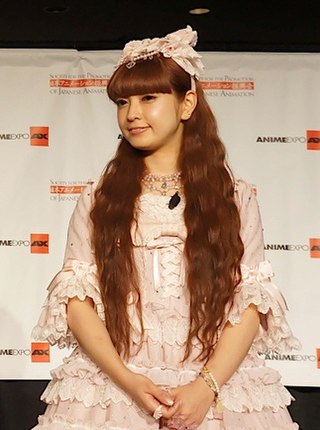Ganguro is a fashion trend among young Japanese women that started in the mid-1990s, distinguished by a dark tan and contrasting make-up liberally applied by fashionistas.

Kawaii(Japanese: かわいい or 可愛い, IPA: [kawaiꜜi]; 'lovely', 'loveable', 'cute', or 'adorable') is the culture of cuteness in Japan. It can refer to items, humans, and non-humans that are charming, vulnerable, shy, and childlike. Examples include cute handwriting, certain genres of manga, anime, and characters including Hello Kitty and Pikachu from Pokémon.
Kogal is a Japanese fashion culture that involves girls wearing an outfit based on Japanese school uniforms. The girls may also wear loose socks and scarves, and have dyed hair. The word kogal is anglicized from kogyaru, a contraction of kōkōsei gyaru.

Gyarupronounced [ɡʲa̠ꜜɾɯ̟ᵝ], is a Japanese fashion subculture. The term gyaru is a Japanese transliteration of the English slang word gal.
Hotaru Akane also known as Anna Akizuki and Hotaru (ほたる) was a Japanese actress, HIV/AIDS activist, and AV idol. She was active in many media formats in Japan including mainstream theatrical film, and was a popular blogger. Her adeptness at female ejaculation in adult videos (AV) earned Akane the title, "Shiofuki Queen". She retired from AV work in 2008.
Ayana Tsubaki is a Japanese TV personality and fashion model.
Hiromi Shinhata, better known simply as Hiromi, is a Japanese fashion model who has been active in the professional and commercial modeling fields since late 2000s. Formerly a popular model for the Egg magazine, she is known for her androgynous looks and is particularly known in the gal scene.

Koakuma Ageha is a gyaru fashion and lifestyle magazine published monthly in Japan. Targeted at females in their late teens and 20s, Koakuma Ageha caters to the styles of Agejo and hime-gyaru. It also incorporates different styles into the agejo style

Ranzuki is a fashion magazine published monthly in Japan by Bunka-sha Publishing & Co.. A gal magazine, Ranzuki mainly targets women in their teens and shows its preference for dark-skin and 109 items.

Arisa Ishikawa, better known by her stage name Sumire (純恋), was a Japanese cabaret hostess and fashion model, who was known as a featured model on the popular gyaru fashion magazine Koakuma Ageha.

I Love Mama was a gyaru fashion and lifestyle magazine published monthly in Japan by Inforest Publishing.

Maryjun Takahashi is a Japanese actress and model of Japanese and Filipino ethnicity who has appeared in CanCam magazine and various television commercials.
Nicole Abe is a Japanese gyaru fashion model who has been featured in Ranzuki (2008–2011) and Happie Nuts gyaru fashion magazines. Abe was once a contributor to Ranzuki.
Hozumi Numajiri, better known as Hozunyam, is a Japanese gyaru fashion model. A hostess living in Tokyo, she is best known for appearing in the Koakuma Ageha fashion magazine and, since her 2010 debut in the magazine, has been well known for her real personal story of a romance with her ex-boyfriend, Bara (バラ), an American motorcycle gang leader.
Megu Fujigamori is a Japanese cabaret hostess, and fashion model best known for appearing in the Koakuma Ageha cabaret-gyaru fashion magazine. A hostess living in Kyoto with genji name "Alice Serisawa", she has regularly appeared in Koakuma Ageha as one of its main models since 2011, and in the magazine, she is commonly referred to by her nickname "Fujimegu" (藤めぐ).
Sayo Hayakawa is a Japanese fashion model. She is best known for her stint as a main model for the Koakuma Ageha cabaret-gyaru fashion magazine.
Sayaka Araki is a Japanese fashion model, disc jockey, and businesswoman. She is best known for her stint as a model for the Koakuma Ageha cabaret-gyaru fashion magazine. She was a major contributor to Koakuma Ageha for 4 years and 10 months, since the magazine's very early days. She left Koakuma Ageha in 2011, and has since become a main model for its sister magazine Ane Ageha.

Misako Aoki is a Japanese model represented by Twin Planet. She serves as the president of the Japan Lolita Association for lolita fashion.
Sayoko Ozaki is a Japanese fashion model. In the past she belonged to the agency Starray Production, and is currently a free agent. She is mainly known as featuring in the magazine Happie Nuts.








